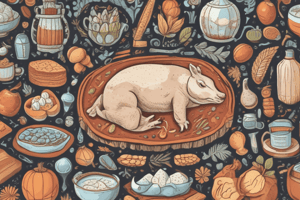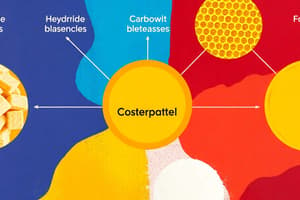Podcast
Questions and Answers
What is the primary function of cellulose in plants?
What is the primary function of cellulose in plants?
- Energy storage
- Nutrient absorption
- Structural support (correct)
- Signal transduction
Which characteristic differentiates hemicellulose from cellulose?
Which characteristic differentiates hemicellulose from cellulose?
- Location within the cell wall
- H-bonding structure
- Resistance to hydrolysis
- Homogeneity of composition (correct)
Which of the following is true regarding pectin?
Which of the following is true regarding pectin?
- Composed mainly of D-glucose units
- Found primarily in the cell wall structure (correct)
- Easily hydrolyzed by mammalian enzymes
- Forms a gel when extracted with cold water
What percentage of a typical cell wall is made up of cellulose?
What percentage of a typical cell wall is made up of cellulose?
Which polysaccharide has extensive H-bonding leading to a tightly bound crystalline structure?
Which polysaccharide has extensive H-bonding leading to a tightly bound crystalline structure?
Which of the following statements is correct regarding pectin?
Which of the following statements is correct regarding pectin?
What is the role of lignin in plant cell walls?
What is the role of lignin in plant cell walls?
What is a primary way absorbed carbohydrates are utilized by animals?
What is a primary way absorbed carbohydrates are utilized by animals?
What percentage of the diet do carbohydrates typically make up?
What percentage of the diet do carbohydrates typically make up?
Which type of carbohydrates is primarily responsible for energy storage in plants?
Which type of carbohydrates is primarily responsible for energy storage in plants?
Which statement about hexoses is true?
Which statement about hexoses is true?
What is the primary function of nonstructural carbohydrates in ruminants?
What is the primary function of nonstructural carbohydrates in ruminants?
Which of the following is NOT classified as a polysaccharide?
Which of the following is NOT classified as a polysaccharide?
What type of carbohydrate helps to form the structure of plant cell walls?
What type of carbohydrate helps to form the structure of plant cell walls?
Which sugar is described as the sweetest and may be important in baby pig diets?
Which sugar is described as the sweetest and may be important in baby pig diets?
Which of the following is a characteristic of pentoses?
Which of the following is a characteristic of pentoses?
Study Notes
Importance of Carbohydrates
- Comprise 60% to 70% of animal diets and serve as a major energy source.
- Energy utilization for microbes supports their metabolism, growth, and protein synthesis.
- Animals primarily benefit from the digestible carbohydrates that escape fermentation in the rumen.
Carbohydrate Classification
- Nonstructural Carbohydrates (NSC): Include storage compounds like sugars and starches.
- Structural Carbohydrates (SC): Constitute cell walls; include hemicellulose and cellulose.
Types of Carbohydrates
-
Pentoses:
- Mainly exist as polymers (pentosans) associated with hemicellulose in cell walls.
- Contribute to energy after microbial fermentation. Ribose plays crucial roles in ATP, DNA, and RNA formation.
-
Hexoses:
- Glucose: Found in fresh fruits and as a starch digestion product; primary energy source and a constituent of sucrose and lactose.
- Galactose: A sugar unit of lactose, converted to glucose in the liver; not found freely in nature.
- Fructose: A ketose sugar, important in baby pig diets, found in fruits and honey; sweeter than glucose.
Disaccharides and Polysaccharides
- Disaccharides include:
- Maltose, isomaltose, sucrose, lactose.
- Polysaccharides include:
- Starch: Main energy reserve in seeds, key energy source.
- Glycogen: Energy storage in animals.
Fiber Definition and Composition
- Fiber is a combination of lignin and polysaccharides indigestible by digestive tract enzymes.
- Typical cell walls comprise 20-40% cellulose, 10-40% hemicellulose, and smaller percentages of lignin and pectin.
Cellulose Characteristics
- Most abundant carbohydrate; a structural component of plant cell walls.
- Composed of beta-1,4-linked D-glucose; resistant to hydrolysis by nonruminants but digestible by microorganisms.
Hemicellulose Characteristics
- A diverse mixture of polysaccharide polymers found in cell walls.
- Easier to hydrolyze than cellulose due to less extensive hydrogen bonding.
Pectin Characteristics
- Non-starch polysaccharide found between and within cell walls.
- Extractable with water, forms gels, and is highly fermentable despite lacking mammalian digestive enzymes.
Lignin Characteristics
- A non-carbohydrate structural component of plant cell walls, providing support.
- Consists of high molecular weight, amorphous polymers derived from phenylpropane.
Studying That Suits You
Use AI to generate personalized quizzes and flashcards to suit your learning preferences.
Description
Explore the significance of carbohydrates in animal diets, including their classification and types. This quiz covers nonstructural and structural carbohydrates, focusing on their roles in energy metabolism and microbial fermentation. Test your knowledge on pentoses and hexoses and their contributions to animal nutrition.




